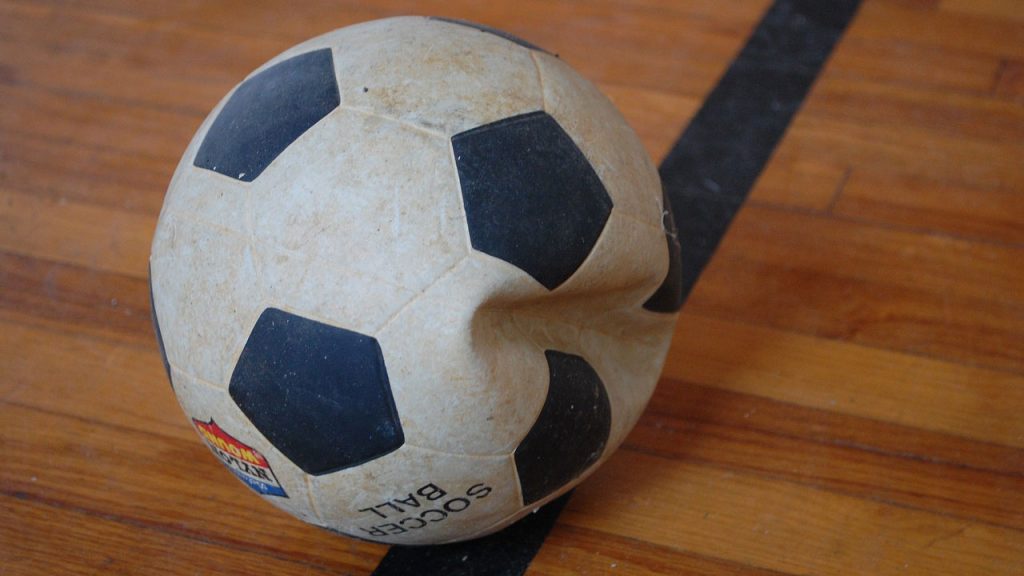Authority Soccer (authoritysoccer.com) is a participant in the Amazon Services LLC Associates Program, an affiliate advertising program designed to provide a means for sites to earn advertising fees by advertising and linking to Amazon.com. This site also participates in other affiliate programs and is compensated for referring traffic and business to them.
The first soccer balls ever made were stitched leather covering pig bladders. Technology and the necessity of a better way to inflate them led to the current synthetic leather covering rubber bladders with valves.
This upgrade allowed their mass production and the agreement on universal size, form, and air pressure. The valves solved the inflating issue for good, but what is the right way to delate a soccer ball?
The better way to deflate a soccer ball is by carefully dipping an inflation needle connected to a pump into the ball’s valve. Once the needle is inside the valve, press the ball gently to expel the ball’s air.
Soccer balls retain the air more or less depending on the type of bladder and valve they have. Butyl bladder balls and butyl valves are the best options for long-term air retention.
Still, the best way to store a ball is to deflate them. If the ball is not going to be used the next day, the best thing to do is extract the air from it.
What should a soccer ball be inflated to?

It is a typical image to see a soccer player press the ball with their hands before a free kick or a corner kick and ask the ref to examine the ball. The ref will press the ball and give the verdict, change the ball.
A partially deflated ball represents an advantage for goalies because it loses its form with ease, making it simpler to catch. A hasty soul would say, well, then the benefit is for both goalies.
Well, not exactly. A team that needs a clean sheet to advance to the next stage will resign attacking and accumulate defenders near its own goal.
It wouldn’t be a bad idea to throw a few deflated soccer balls to the pitch to make their goalkeeper’s life more comfortable.
But that is cheating. FIFA established that a professional soccer ball must have between 8.5 PSI (Pound Per Square Inch) to 15.6 PSI of air pressure. Every soccer ball must fit into those parameters to be utilized in a professional match.
When a soccer ball is under 8.5 psi, the players quickly detect it and ask for a replacement. However, a deflated ball isn’t necessary a cheating strategy; some balls lose air pressure more often than others; it depends on the type of bladder they have.
Latex bladder balls react better to the player’s kicks and have a more consistent bouncing, but they tend to retain the air for short periods. That’s why they’re the chosen ones for professional matches.
Butyl bladder balls can keep the air for more extended periods, but their responsiveness and bouncing is not as good as latex bladder balls. They’re the favorites for training.
A deflated latex bladder ball might appear because it wasn’t inflated for that game, but it was filled a day or a few days before.
Ideally, before every soccer game, the game officials must inspect the soccer balls that will be used in the game. However, it’s the head referee’s responsibility to check and confirm the balls meet the criteria demanded by FIFA before the game.
How to Deflate a Soccer Ball the right way
Before Charles Goodyear vulcanized the first rubber bladder ball, balls were made out of pig bladders; soccer balls lack uniformity in their size and shape. Goodyear’s invention changed the soccer balls industry (among others) forever.
Rubber bladders offered the possibility of establishing standards of size, shape, and air pressure on the soccer balls. But still, the brand new rubber bladders need to be blown to inflate them.
People would get sick and even die of blowing the bladders to inflate soccer balls. H.J Lindon’s wife died from a lung condition after blowing too many bladders. Motivated by his loss, the man invented the rubber bladder’s valves.
The valves became vital to inflate the soccer balls, there was no need anymore to blow, and they could be filled with a pump. But it didn’t stop there; the valves are also handy to deflate soccer balls.
If you want to deflate a ball the ideal way, you need an inflation needle and a pump. The inflation needle needs to be plugged into the pump.
- Find the valve – Some soccer balls have their valve signalized; if they don’t, you need to look for a tiny hole in the outer cover the size of a nail’s head.
- Lubricate the inflation needle – You can use any kind of lubricant or even saliva. This will facilitate the insertion of the needle into the valve.
- Insert the needle into the valve – Be careful here; the hole in the other cover is an indicator of the valve’s position. But the valve might move slightly to the sides (especially if the ball is a little deflated). Be mindful of that and insert the needle slowly, avoiding perforating the bladder if the valve has moved a bit.
- Release the air – The pump is important to prevent the ball from releasing the air all at once, which could be harmful to the bladder. The pump’s inflation mechanism will produce some resistance to the air coming out from the ball, forcing it to reduce its speed.
- Press the ball a bit – Squeeze the ball softly so and help the air to abandon the bladder. Don’t press too hard, and keep pressing until the ball is entirely flat. During this process, ensure the inflation needle is well placed and avoid moving it to the sides.
Removing the air of a soccer ball between uses is vital to ensure its long life. This is because bladders are meant to be used inflated, but keeping them that way for long periods is harmful in the long run.
The valve’s mechanism to avoid the air from escaping from it “gets tired” and lose effectiveness if the ball is inflated for long periods.
Deflating the bladder frequently increases its useful life. But deflating a soccer ball is not only good for the bladder; a deflated soccer ball is also easier to carry and stock.
How do you deflate a Soccer ball without a pump?

Deflating a soccer ball without a pump and an inflation needle is not the best idea. You can end up ruining your ball for good. Still, if you need to deflate a soccer ball and there is no pump and needle at sight, here’s how you can pull it out.
You need a paper clip or any other object you can think of thin enough to get into the ball’s valve, not sharp nor pointy.
Perhaps to deflate a soccer ball using this technique, you might need an extra pair of hands to assist you. You will need steady hands to introduce the paper clip or the object of your choice and avoid breaking it inside the bladder.
- Moisten the paper clip – The process of moistening the paper clip is necessary to avoid perforating the ball’s valve. You can moisten your tool with saliva as well, but it is recommended to use some kind of oil or lubricant. As we are already improvising on the device, let’s use a proper lubricant.
- Stick the paper clip into the valve – You need to straighten the paper clip as much as you can. It needs to be as long as an inflation needle. Be mindful of not introducing a softened part of the clip; you don’t want to leave a portion of it inside the bladder.
- Eliminate the air – Once the end of the paper clip is inside the valve, help the air abandon the soccer ball with gentle pressure. Squeeze gently but hold the paper clip firmly; perhaps a piece of fabric can assist you in this task.
- Get a flat soccer ball – Make sure you get all of it out of the bladder. Once the ball is flat, remove the paper clip carefully, and you’re done.
There is another option for those who enjoy applying technology to manual labor and those who appreciate technological advances. An electric pump can solve several issues and make things easier when inflating and deflating the ball is the subject.
It is programmable, inflating or deflating a ball until the desired PSI. It also has a digital display that allows the user to select accurate PSI values.
Electric pumps are small, light, and very easy to carry. They definitely make things easier; after selecting the desired PSI, you only need to place the needle inside the valve, and the electric pump will do the rest.
It is rechargeable, so you don’t need to worry about getting batteries or anything like that.
Apart from making things easier the inflation and deflation process, electric pumps give the opportunity of being very specific in the air pressure you decide to put into your soccer ball. It eliminates second-guessing and suppositions.
This equipment works not only on soccer balls but on any kind of sports ball with a valve. It is ideal for coaches and trainers who need to inflate and deflate several soccer balls daily.


